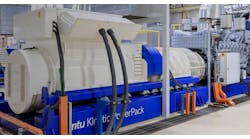In this microgrid case study we look at how the Illinois Institute of Technology increased power reliability and saved millions in electrical system upgrades by installing a smart microgrid.
Photo of IIT, courtesy of Joe Ravi/Shutterstock.com
Background
The Main Campus of the Illinois Institute of Technology in Chicago was experiencing one to three major outages per year, each costing an estimated $520,000 in restoration expenses. The remedy would be extremely expensive.
The existing North and South Substations of the campus were served by three 15-kV feeders from Exelon’s Fisk Substation and one 15-kV feeder from Exelon’s Pershing Substation. Upgrades to the Fisk Substation would be needed, totaling approximately $2 million.
The campus distribution system consisted of nine 4.16-kV radial feeders from the South Substation and six 4.16-kV radial feeders from the North Substation. These substations were operating at maximum capacity. A new $5 million substation and additional feeders would be needed at the east end to serve new housing, along with expanded academic and research facilities throughout the campus.
In 2008, the Galvin Electricity Initiative launched a project with IIT faculty, Endurant Energy, Exelon, and S&C Electric to develop a Perfect Power System prototype for the campus. Their definition of perfect power was simple: “a system that cannot fail to meet the needs of the individual end-user.” Key to their vision was the conversion of the campus’ electrical system into a “Smart Microgrid.”
What Did They Do?
Existing on-site cogeneration equipment was repurposed to operate in “islanding mode,” independent of the Exelon system. This equipment includes a 6-MW fast-start, gas-fired generator having the ability to produce essential power in the event of a problem on the Exelon system, plus ten standby generators located at various buildings around the campus, producing a total of 3 MW. The power generated on-campus will be sold on the wholesale market to PJM Interconnection, a regional transmission organization.
The need for the new substation and additional feeders was eliminated through the application of S&C’s High-Speed Fault-Clearing System throughout the campus. This unique system clears main feeder faults in approximately six cycles and isolates the faulted cable section . . . while maintaining service to all
connected loads.
Details of S&C’s Solutions
S&C furnished a wide range of products and services for the project, including the following:
- A CYME model of the existing 15 radial feeders.
- A load flow study, short-circuit study, arc-flash hazard analysis study, and over current protective device coordination study for the existing fifteen feeder system.
- Design of a new seven-closed-loop High-Speed Fault-Clearing System.
- Electrical and physical design for new Loops 1, 2, and 3, fed from North Substation. The electrical design included a load flowstudy, voltage drop
analysis, short-circuit analysis, and over current protective device coordination study. - Design of the fiber-optic communication system for each loop, including the interface to the master controller.
- Design of the conversion from electromechanical relays to microprocessor-based relays for the North Substation feeder breakers.
- Manufacture of eight Vista® Underground Distribution Switchgear units for Loops 1 and 3, and seven Vista Switchgear units for Loop 2.
- Commissioning of Loop 3.
To see a diagram of the of the high reliability distribution system at the Illinois Institute of Technology download a PDF of this case study courtesy of S&C Electric.







